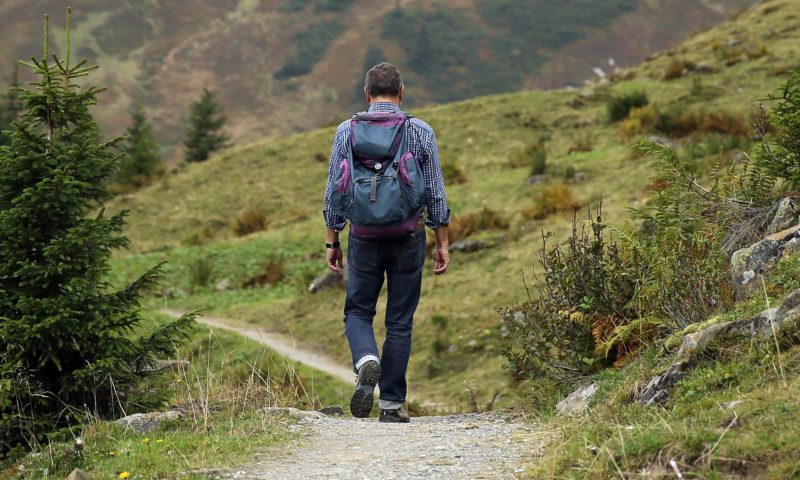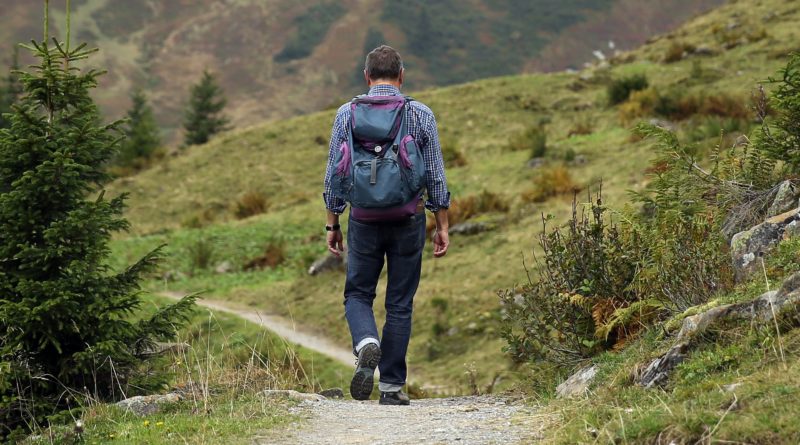Top 5 Gadgets for Long Hikes
(Last Updated On: )
Please enjoy our guest post from Tyler Michaelson.
Back when I was growing up, camping and hiking used to be a lot more challenging than it is today. One of the reasons is that hiking trails are far better maintained nowadays, but it is also because of the fact that technology has significantly evolved in the past two decades, and now we have access to a wide array of gadgets that can make spending time in the wilderness much easier and much less of a hassle.
I was extremely skeptical about most of these gadgets until I saw how useful some of them were first-hand, and these days there is no chance that I would leave for a big hike without bringing these five things with me.

1. Solar Charger
Fact: Phone batteries tend to die pretty fast. Even faster if you tend to use your device a lot, and this has always been a problem when you’re out in the wilderness and your phone runs out of juice. I can think of at least three scenarios where I was separated from a person in my group and failed to contact them, either because my phone battery had died, or theirs had.
A while back, I used to carry multiple batteries for my phone so I could just swap it out when the first one dies, but this is basically useless if you’re out in the woods for more than, say, seven days (and even then you have to be conservative with your battery power). Then a friend suggested that I order a solar charger for my phone, which actually made a lot of sense; the sun is an endless supply of energy, and with the right tools you can harness it anywhere. Nowadays, there’s not a chance that you’ll catch me with my Smartphone off during a hike, because it’s always charged. My personal favorite is the Nekteck Solar Charger, it’s never failed to keep my Nexus working with just an hour or two under the sun per day (then again, I am sparingly conservative with my battery, I don’t get the phone out unless I really need to).
2. Pressure Shower
I don’t know about you, but I’m the type of person that takes at least one shower a day, more often two. So when I’m out in the woods and getting super dirty, all that grime collecting beneath my fingers and the dust and dirt that basically gets everywhere is something that becomes really annoying really fast. For this reason, I basically never leave for a hike without my pressure shower, that allows me to stay squeaky clean even in the filthiest of situations.
A good pressure shower will run you about $150 at most, and they’re built to last a lifetime, so it’s a really small investment that can make your life infinitely easier, especially if you’re a clean freak like yours truly. When empty, this kind of shower will weigh up to a mere 2 lbs and it can pack down to 6 x 9 in. so you can easily fit it into your backpack, but when filled up it can hold up to three gallons of water, which is more than enough for any reasonably lengthy shower.
3. Portable Water Filter
Getting fresh water during a long hike used to be a big problem when I was younger, especially during the summer. No matter how much we used to bring, we’d almost always go through our fresh water supply at about 70 percent of the entire road. Fortunately, most of us knew that getting fresh water from a nearby creek is something that you can do pretty easily. All you need is a piece of gauze to filter out any large pollutants in the water, and then you simply boil it to kill any harmful pathogen inside.
These days, though, it’s definitely safer and easier if you just get yourself a water filter to do this job for you. There are UV filters that can treat your water and make it safe to drink in mere seconds, so that’s something that you should definitely look into if you like to go on long hikes. Just keep in mind that these filter require batteries in order to function, so you need to bring quite a few spares with you if you’re going to use it constantly. Trust me, you don’t want to be stuck without a water filter and no fresh water, especially if you’re hiking during the summer.
Alternatively, if you need to purify large volumes of water, you might want to look into a pump water filter as well, as most UV filters can’t really handle large quantities of water at once.
4. LED Headlamp
Most people tend to forget that you’ll sometimes have to wander away from your campfire in the middle of the night. They also forget that there are no street lights out in the wilderness, and that basically your only natural source of illumination is your campfire and the moon – that is, unless you pack some artificial light.
I learned the importance of this firsthand when a friend of mine had wandered away from the camp at night and gotten lost, so I had to go and retrieve him. Fortunately he had a flashlight with him, but I did not so I had to keep my lighter on the whole time just so I could see where I was going and not trip over a root or something. Eventually I saw the light from his torch and we safely returned home, but I never made the mistake of going out into the woods without some battery-powered illumination again. My personal choice is an LED headlamp, because a) they’re really bright, b) the light itself disperses to a really large area compared to an incandescent lightbulb, and c) your hands remain free at all times since the lamp is located on your head.
Additionally, the efficiency of LED technology far exceeds both incandescent and luminescent bulbs, so your batteries will last much longer and you won’t have to bring as many spares as you usually would. If you like going on really long hikes, it might be a good idea to invest in a solar powered headlamp as well. I find that the Hybridlight Headlamp works really well, although I’ve only had the opportunity to use it once or twice and do not own one personally.

5. Dedicated GPS Device
For years, I used to insist on using nothing but a map and compass to keep track of my position in the wilderness, until my sister basically begged me to give her GPS device a chance. The reason behind my partially justifiable prejudice was that I really don’t like to trust a device that becomes useless once the batteries run out, and you have no means of replacing them. However, I was really pleasantly surprised at the battery life of her device, and getting back to our trail was a breeze when you have the help of a device that literally tells you where you need to go.
Note that I’m still an advocate of having a map and compass with you anyway because they can’t die on you like any sophisticated piece of technology can, but I’m far less partial towards this than I was before.
A side note from 14erskiers – we highly recommend a personal locator tied with a GPS such as the Garmin inReach (formerly Delorme inReach).
That about covers all the basic gadgets that I highly recommend everyone should have when they’re out in the wild, as they can really make your life infinitely easier. Being away from civilization doesn’t always mean being absolutely separated from technology, as technology is exactly what made it possible for a creature as frail as a human to be able to survive in virtually any conditions. It’s time to pack up your gadgets and head out into the great unknown, and I wish you the best of luck in doing so!
 A 32 years old adventurer and writer, Tyler Michaelson’s main hobbies include time outside, writing, calisthenics and TV shows. He’s a part-time blogger at http://www.prosurvivalist.com
A 32 years old adventurer and writer, Tyler Michaelson’s main hobbies include time outside, writing, calisthenics and TV shows. He’s a part-time blogger at http://www.prosurvivalist.com
- Where to Find the Best Off-Piste Skiing in the Alps - November 11, 2018
- Top 5 Gadgets for Long Hikes - July 16, 2017
- Best Hikes for Any Time of Year - October 16, 2016



I agree with 4 of 5 of your list. I would drop the pressure shower but add one or more of the light weight “big three” cook system, sleep system or shelter. Function has improved and weight has decreased in all of the big three very dramatically in the last 20 years.
I started backpacking and backcountry skiing when propane stoves and an aluminum pot was the best think going. A light weight 2 person tent was made out of modern “ripstop nylon” but still weighed nearly 5 lbs including stakes and poles. A down stepping bag was all the rage but sleeping pads still weighed more than most were willing to carry or provided very limited R value and needed constant patching.
We have thing pretty good these days.